A very effective pure sine wave inverter circuit can be made using the IC 4047 and a couple IC 555 together with a few other passive components. I have explained the details below.
The Circuit Concept
In the previous post I explained the main specifications and datasheet of the IC 4047 where I have explained how the IC could be configured into a simple inverter circuit without involving any external oscillator circuit.
In this article we carry on the design a little ahead and learn how it can be enhanced into a pure sine wave inverter circuit using a couple of additional ICs 555 along with the existing IC 4047.
The IC 4047 section remains basically the same and is configured in its normal free running multivibrator mode with its output extended with the mosfet/transformer stage for the required 12V to the AC mains conversion.
How the IC 4047 Functions
The IC 4047 generates the usual square waves to the connected mosfets creating a mains output at the secondary of the transformer which is also in the form of square wave AC.
The integration of the two 555 IC to the above stage completely transforms the output into a pure sine wave AC. The following explanation reveals the secret behind the IC555 functioning for the above.
Referring to the below shown IC 4047 pure sine wave inverer circuit (designed by me), we can see two identical IC 555 stages, wherein the left section functions as a current controlled sawtooth generator while the right hand side section as a current controlled PWM generator.
The triggering of both the 555 ICs are derived from the oscillator output readily available across pin#13 of IC 4047. This frequency would be 100Hz if the inverter is intended for 50Hz operations, and 120Hz for 60Hz applications.
Using IC 555 for the PWM Generation
The left 555 section generates a constant sawtooth wave across its capacitor which is fed to the modulating input of the IC2 555 where this sawtooth signal is compared with the high frequency signal from pin3 of IC1 555 creating the required pure sine wave equivalent PWM at pin#3 of 555 IC2.
The above PWM is directly applied to the gates of the mosfets. so that the square pulses here generated through pin10/11 of IC4047 gets chopped and "carved" as per the applied PWMs.
The resulting output to the transformer also causes a pure sine wave to be stepped up at the mains AC secondary output of the transformer.
The formula for calculating R1, C1 is given in this article which also tells us about the pinout details of the IC 4047
For the NE555 stage C may be selected near 1uF and R as 1K.

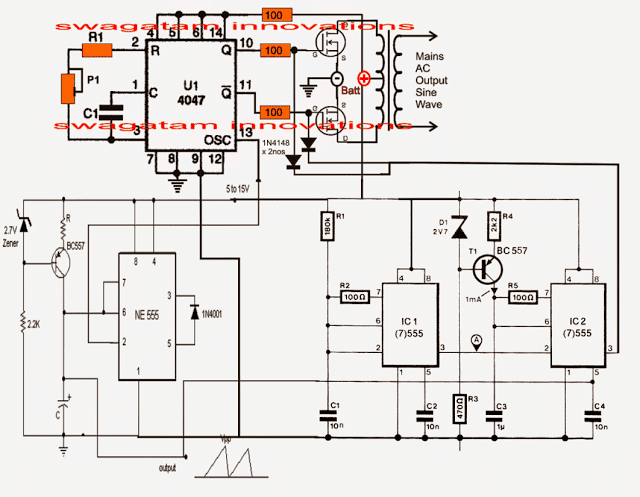
Assumed output waveform
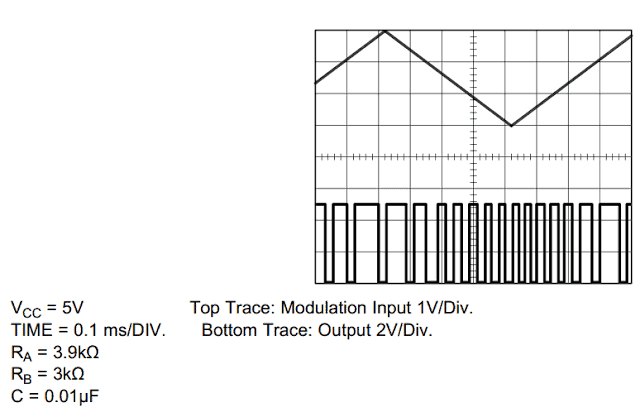
More info on how to use IC 555 for generating PWM
An RMS adjustment could be added to the above design by introducing a pot voltage divider network across pin5 and the triangle source input, as shown below, the design also includes buffer transistors for improving mosfet behavior
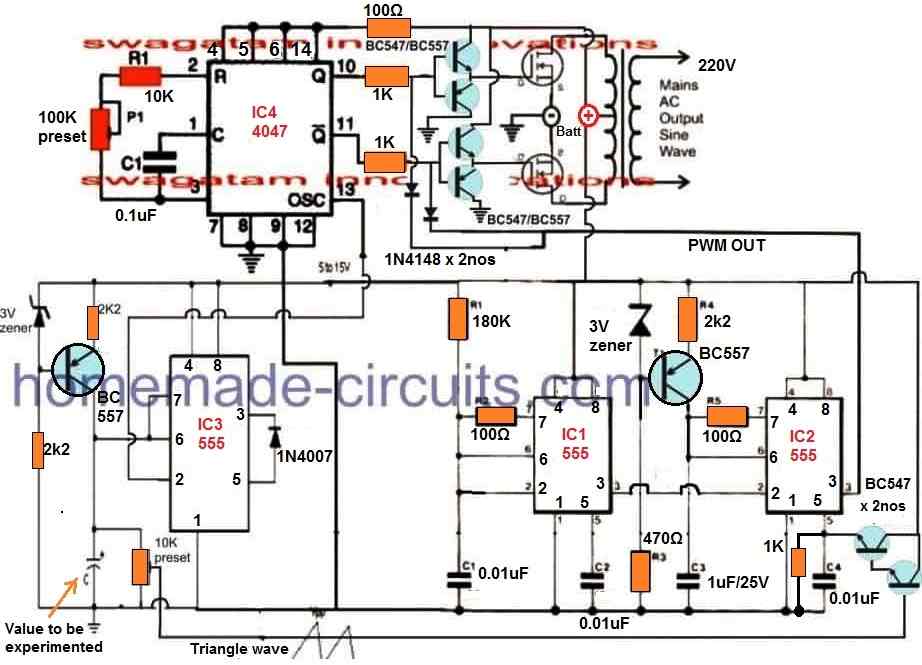
The above pure sine wave inverter design was successfully tested by Mr. Arun Dev, who is one of the avid readers of this blog and an intense electronic hobbyist. The following images sent by him prove his efforts for the same.


More Feedback
Inspiring response received from Mr. Arun regarding the above IC 4047 inverter results:
After completing this circuit, the result was amazing. I got full wattage by the 100 W bulb. Couldn't believe my eyes.
The only difference i had made in this design was replacing the 180 K in the second 555 with a 220 K pot to adjust the frequencies accurately.
This time the result was fruitful in all respects... On adjusting the pot, i could get a non disturbing non flickering full wattage glow in the bulb, also the 230/15 V transformer connected as the load gave a frequency in between 50 and 60 ( say 52 Hz ).
The pot was adjusted gently to get a high frequency ( say 2 Khz ) output from pin#3 of second ic 555. The CD4047 section better calibrated to get 52 Hz at the two output terminals....
Also I am facing a simple problem. I have used IRF3205 mosfets at the output stage. I forgot to connect the safety diodes across the drain terminals of each mosfets...
So when I had tried connecting an another load ( say table fan ) in parallel to the given load ( 100 W bulb ), the glow of the bulb also the speed of the fan was reduced a little and one of the MOSFET was blown due to the absence of the diode.
The above 4047 sine wave inverter circuit was also tried successfully by Mr. Daniel Adusie (biannz), who is a regular visitor of this blog, and a hardworking electronic enthusiast. Here are the images sent by him verifying the results:
Sawtooth Waveform Oscilloscope Output

Illuminating a 100 Watt Test Bulb

The following images show the modified waveforms at the output of the transformer as captured by Mr. Daniel Adusie after connecting a 0.22uF/400V capacitor and a suitable load.
The waveforms are somewhat trapezoidal and are far better than a square wave which clearly shows the impressive effects of the PWM processing created by the IC555 stages.
The waveforms could be probably even further smoothened by adding an inductor along with the capacitor.
Showing an near Sinewave Oscilloscope Trace after PWM Filtration
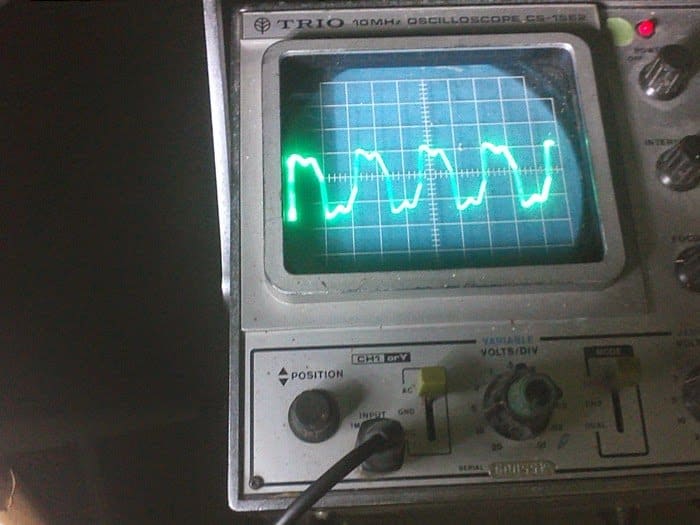
Interesting feedback received from Mr. Johnson Isaac who is one of the dedicated readers of this blog:
Good day
In your post, Pure Sine Wave Inverter using 4047, in the second I.c stage (ic.1) you used 100 ohms resistor in between pin 7 and 6.,
Is that correct? I use to think an astable multivibrator using 555 pin configuration should have the 100 ohms between pin 7 and 6. Also, the 180k variable between pin 8(+) and pin 7. Pls check the pin connection and correct me pls. Because it oscillate sometimes and it doesn't sometimes also. Thanks,
Isaac Johnson
Solving the Circuit Issue:
In my opinion, for a better response you can try connecting an additional 1k resistor across the 100 ohm outer end and pin6/2 of IC1
Johnson:
Thank you very much for your response. I actually constructed the inverter you gave in your blog and it worked.
Though I don't have an oscilloscope to observe the output waveform BUT I bet readers its a good one cos it operated a fluorescent tube lamp in which any modified or pwm inverter can't power on.
See the picture sir. But my challenge now is when I add load, the output flickers sometimes. But am happy its a sine wave.
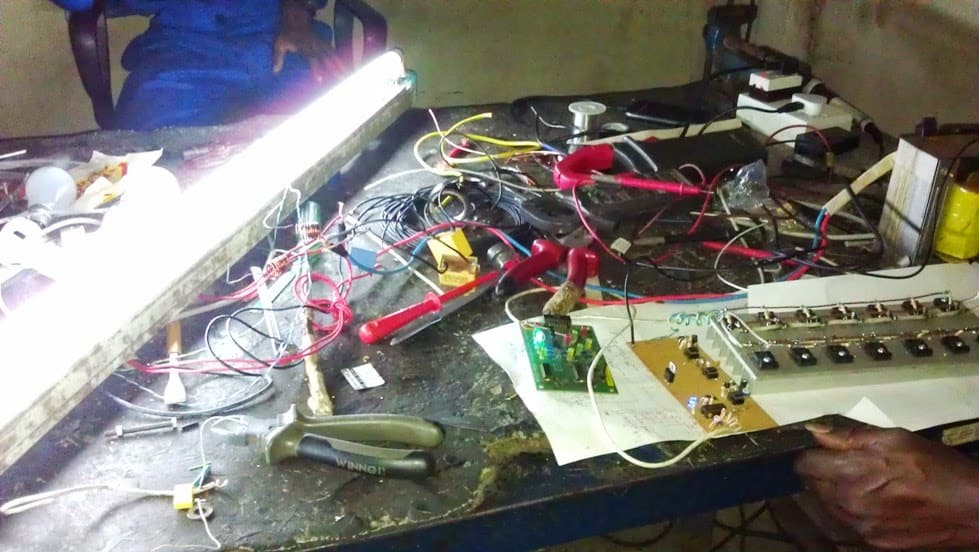
Video Test Waveform
Simplifying the above Concept
The above explained IC 4047 pure sine wave inverter can be actually simplified greatly by eliminating two IC 555 configurations from the design.
The basic idea is to produce a synchronized sine PWM output for chopping the MOSFET switching so that this SPWM waveform is replicated at the output of the transformer and is transformed into a pure sine waveform. The complete circuit diagram can be seen in the following diagram:
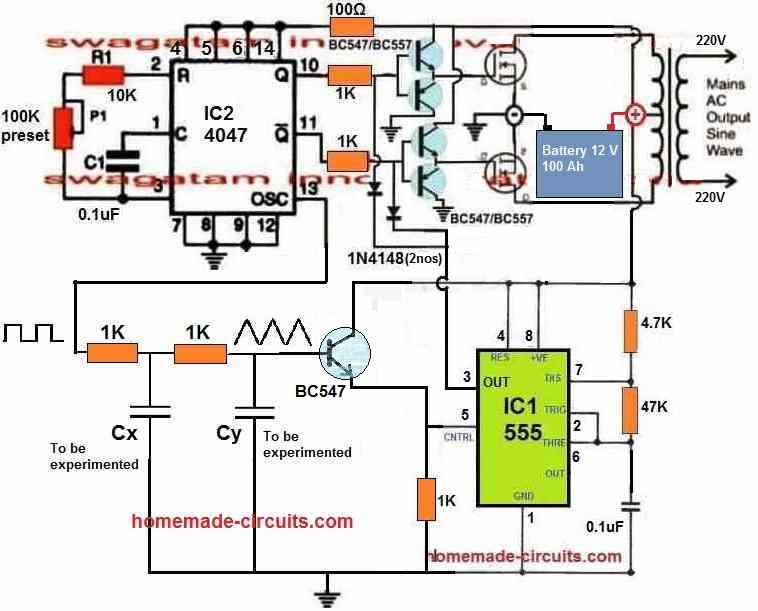
In this simplified design, we yet again exploit the pin#13 square wave output from the IC 4047 and convert it into triangle waves. This triangle wave is then used to modulate the PWM output of a IC 555 astable to create the required synchronized SPWM for chopping the MOSFET gates.
The capacitors Cx and Cy will need to be experimented a bit to create a proper triangle waves from the RC network output.
Remember, you will need an oscilloscope to check and confirm the various waveform discussed in the above diagram.
Another Simpler Looking Options
The following concept discuses a rather simpler method of modifying an ordinary square wave inverter using IC 4047 into a sine wave inverter through PWM technology. The idea was requested by Mr. Philip
Technical Specifications
I hope that i am not going to be a bother, but I need some advice with a PWM-controlled modified sine wave inverter I am designing so I want to seek your expert opinion.
This simple design is tentative, I haven't implemented it yet but I would like you to take a look at it and tell me what you think.
Also I want you to help answer some questions which I have not been able to find answers to.
I have taken the liberty of attaching an image of a quasi-block diagram of my tentative design for your consideration.
Please help me out. In the diagram, the IC CD4047 in the inverter is responsible for generating square wave pulses at 50Hz which will be used to alternately switch on MOSFETS Q1 and Q2.
The PWM circuit will be based on IC NE555 and its output will be applied to the gate of Q3 so that Q3 will provide the PWM. Besides this, I have two questions.
First, can I use square waves for the PWM pulses? Second, what is the relationship between PWM frequency and supply frequency? What PWM frequency should I use for a 50Hz inverter output?
I hope that this design is feasible, I think it is feasible, but I want your expert opinion before I commit scarce resources to implement the design.
Looking forward to hearing from you sir!
Sincerely, Philip
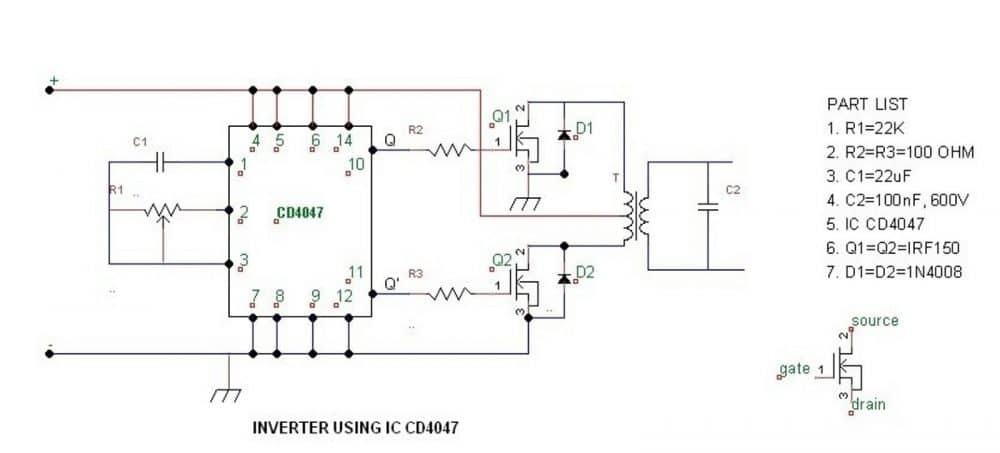
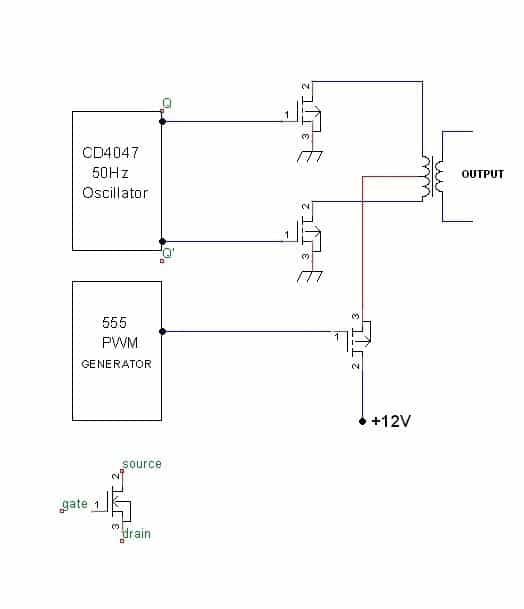
Solving the Circuit Request
The configuration shown in the second figure above would work only if the center tap mosfet drain/source pins are swapped and N-channel mosfets are used for the 4047 inverter oscillator output, as shown below:
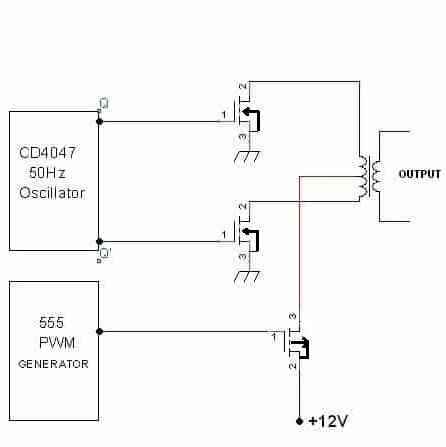
The PWM section should be built as I have explained in this article:
The PWM transforms the flat square waves into a modified square wave by chopping them into smaller calculated sections such that the overall RMS of the waveform becomes as close as possible to an actual sine counterpart, yet maintaining the peak level equal to the actual square wave input. The concept may be learned in details here:
However the above transformation does not help to eliminate the harmonics.
The PWM frequency will be always in the form of chopped square waves.
The PWM frequency is immaterial and may be of any high value, preferably in kHz.
How to Add Feedback Voltage Control to a 4047 IC Inverter
In this section we will discuss how to add an automatic feedback voltage control to a 4047 IC based inverter circuit.
If you don't want to read the whole explanation, you can watch the following video instead:
This type of feedback network is intended to ensure that the AC output voltage from the inverter never exceeds a predetermined safe value. For example, using this automatic feedback control, a 220 Volt inverter circuit output could be restricted to maximum 230V AC level, which may be safe for most 220 Volts appliances.
For a 120 Volt inverter system, this feedback network could be adjusted to restrict the output AC to a maximum of 115 Volts AC, which may be safe for most 110 Volt appliances.
How the Feedback Circuit Works
Now let's understand how the simple feedback network is designed to work, by referring to the following circuit diagram:
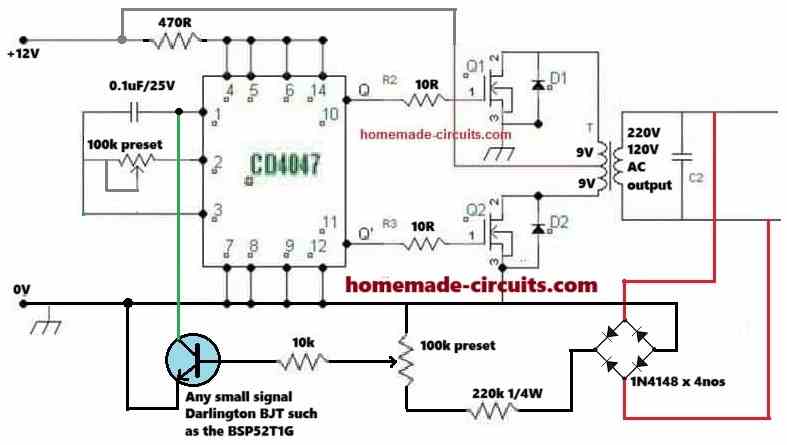
The mains AC voltage from the inverter transformer secondary is first converted to a DC voltage using a bridge rectifier.
This bridge rectifier is built using 4 numbers of 1N4148 diodes.
The DC 220 Volts output from the bridge rectifier is applied to an adjustable voltage divider network built using a 220 k resistor and a 100 k preset or trimpot.
The 100 k preset is carefully adjusted such that its central wiper terminal generates around 1.2 volts in response to an input AC voltage which is considered high, and needs to be restricted.
Let's say, the input AC needs to be restricted at around 270 Volts, then the 100 k preset may be adjusted so that its wiper terminal generates a proportional DC voltage level of 1.2 Volts.
We select a 1.2 Volt output because this is the equivalent DC level required to just switch ON the attached BJT device.
That means, whenever the inverter output AC voltage tries to exceed the 270 Volts mark, it causes the BJT to turn ON and become conductive.
When the BJT conducts, it starts grounding the CT pin of the IC 4047.
Since the RC network associated with the CT and the RT pinouts of the IC determines the output frequency and PWM, the grounding of the CT pin instantly causes the output PWM and frequency to nullify, which in turn causes the output AC voltage to dip.
When this happens, the feedback voltage to the BJT also drops proportionately until the BJT is turned off. In this situation the IC output PWM is restored back to its previous form, and if the output voltage continues to rise, it yet again activates the BJT via the feedback network, and this feedback on off cycle keeps repeating rapidly, ensuring that the output AC is not able to rise above the set threshold, which is 270 volts in our example.
This concludes our feedback control circuit explanation, now let's try to understand how this feedback circuit can be setup prior to integrating it with the inverter circuit.
How to Setup
The next diagram below shows the isolated feedback circuit, which can be set up by implementing the following steps, before interfacing it with your inverter circuit:
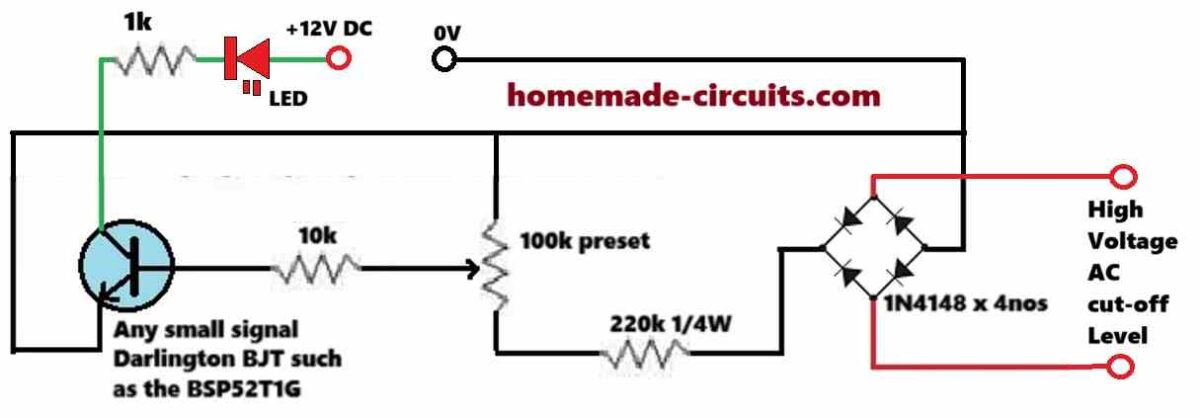
Initially keep the 100k preset's wiper arm fully towards the ground side of the DC supply.
Now, switch ON the 12 DC supply and then switch ON the AC supply to the bridge rectifier whose voltage level is around the desired high cut-off limit.
Next, slowly adjust the preset using a well insulated screw driver, until the LED just begins to illuminate.
To confirm the results, try varying the input AC voltage around the cut-off threshold and watch the LED turn on and off at the thresholds. Although the cut-off may not be too sharp, yet it will do the job of the intended output voltage control of the inverter quite well.
That's it! This simple procedure should be enough to complete the setting up of the feedback circuit.
After this, make sure to seal the preset adjustment with some super glue.
So, this concludes our explanation on a feedback circuit for the 4047 inverter.
Pseudo-sinusoidal IC 4047 Inverter Circuit
From a continuous source, battery, or vehicle alternator, it is possible to produce a 50 Hz voltage/pseudo-sinusoidal waveform, using this simple IC 4047 inverter circuit. The design is capable of operating many low-power devices that require a voltage of 220 V AC, typically supplied by the AC mains grid distribution network. The power of this module depends largely on the chosen transformer and, above all, on the continuous source's ability to supply the circuit without failure.
Working Principle of the circuit
Being able to power a device on the 220 V AC network when no mains AC power is available can be very convenient. We particularly think of campers, caravanners, fishermen, and motorists.
Although this simple setup does not provide a 100% clean sinusoidal wave, it can still satisfy many undemanding devices such as incandescent or fluorescent lighting, soldering irons, small motors, etc.
The power can reach up to 250 VA if the continuous source is strong enough and an adequate toroidal power transformer is chosen.
The power transistors are rated for 30 A, provided that a substantial heatsink is used.
We even suggest adding a small fan directly connected to the 220V output, which will prevent it from operating without a load.
Analysis of the Circuit Diagram
To obtain an alternating voltage from a DC source, the simplest solution is to use an inverted transformer: the low-voltage secondary winding has a center tap.
It is then sufficient to alternately supply power to the two windings to produce a symmetrical, but non-sinusoidal, variable voltage on the primary side if the low-voltage secondary winding is driven by a rectangular signal with steep edges.
Two complementary and opposite signals are required, and the CMOS integrated circuit with the reference 4047 is used to generate them, capable of either building an astable or monostable flip-flop.
The proposed diagram is shown in the figure below.
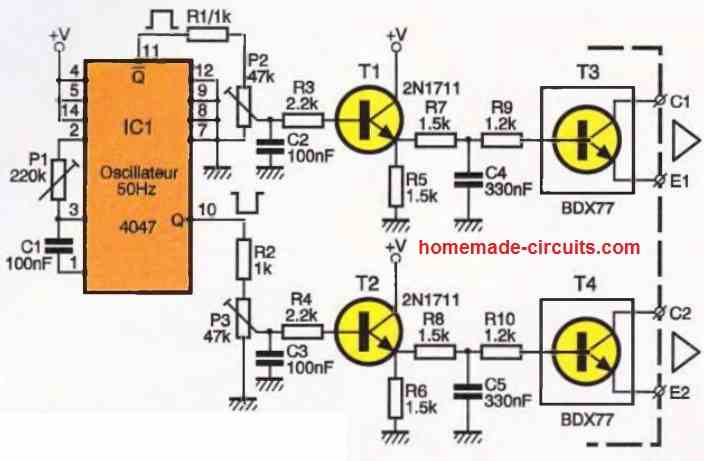
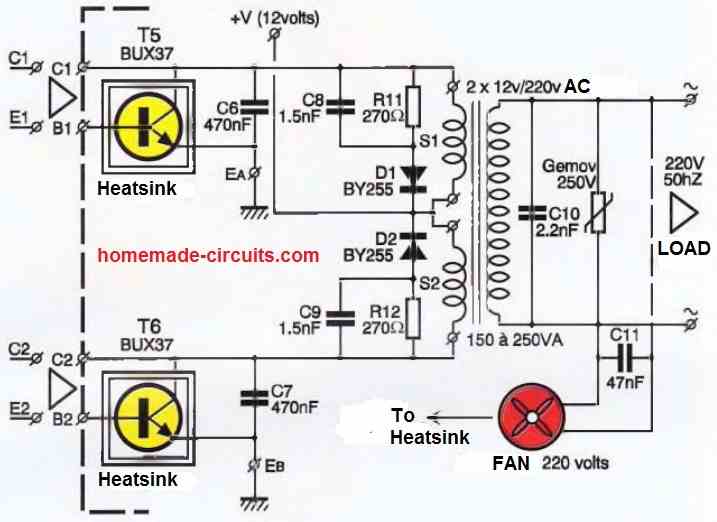
Of course, we will operate our circuit as an astable generator, ensuring a precise frequency of 50 Hz. This task is entrusted to components C1 and P1. Some pins of the IC1 circuit are connected to the ground or the positive supply, depending on our needs.
For more information, you will find an explanation in the appendix about the multiple possibilities of this practical little integrated circuit.
The symmetrical square voltages available at pins Q and Qdash (corresponding to terminals 10 and 11 of the circuit) are routed through resistors R1 and R2 to an adjustable element. Its role is to balance the amplitude of the two signals and facilitate the adjustment of the control module.
Note that the duty cycle will be exactly 50% by design. The sliders of elements P2 and P3 control the base of a 2N1711 transistor, which is responsible for driving the downstream power semiconductors.
Components R7, R9, C4, as well as R8, R16, and C5, form a coarse filter capable of smoothing out the signal angles to some extent.
This will allow us to create a "pseudo-sinusoidal" signal that will control the intermediate transistors T3 and T4 mounted on the small control board.
The BDX 77 models are rated for an emitter-collector voltage of 80V and a maximum peak current of 8A. They are delivered in a TO-220 package and will benefit from a heatsink.
The secondary windings of the transformer do have a common point connected to the positive pole of the power supply.
The other end of the coils will receive the ground through the power transistors T5 and T6, a model not much larger than the famous 2N3055 but with a maximum peak current of around 30A in this case.
It is the NPN bipolar model with the reference BUX 39.
Diodes D1 and D2 absorb the unavoidable breakdown current produced at each interruption of the inductive element, which is the transformer.
The primary of the transformer, a toroidal model in this case, delivers a 50 Hz AC voltage.
The component labeled Gemov (or varistor) is placed between the output pins to clamp excessive voltage surges that may occur.
Two wires can also be tapped from the output to operate a fan directly powered by 220V, which will provide airflow to cool the transistor-heatsink assembly.
It is important to ensure that the voltage of the continuous source does not drop too much or be completely depleted in the case of a lead-acid battery.
It goes without saying that the input DC current can reach considerable values if, for example, a power of 200VA is desired. It would be prudent to include a robust series fuse, similar to those found in a household installation.
Construction
The creation of two printed circuit boards is necessary: the first one, shown in the figure below, is designed for the components described in the control module.
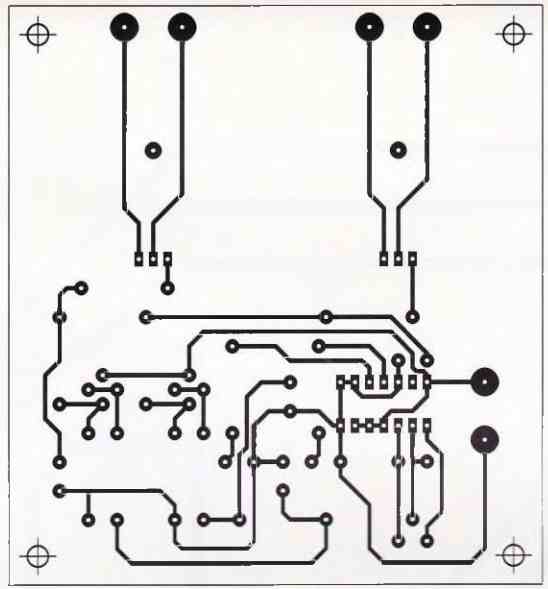
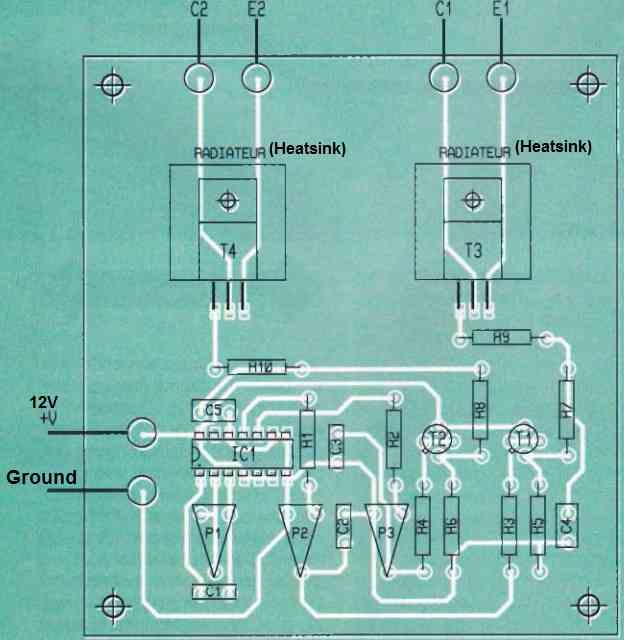
The layout is not very dense, but it is still recommended to use pre-sensitized copper-clad boards for reproduction.
After etching and rinsing, various drillings are carried out. Care must be taken to carefully mount transistors T3 and T4 on a small heatsink, which is directly attached to the epoxy board.
From this board, six wires will go to the significantly larger power module, and the track layout at a 1:1 scale can be found in the figure below.
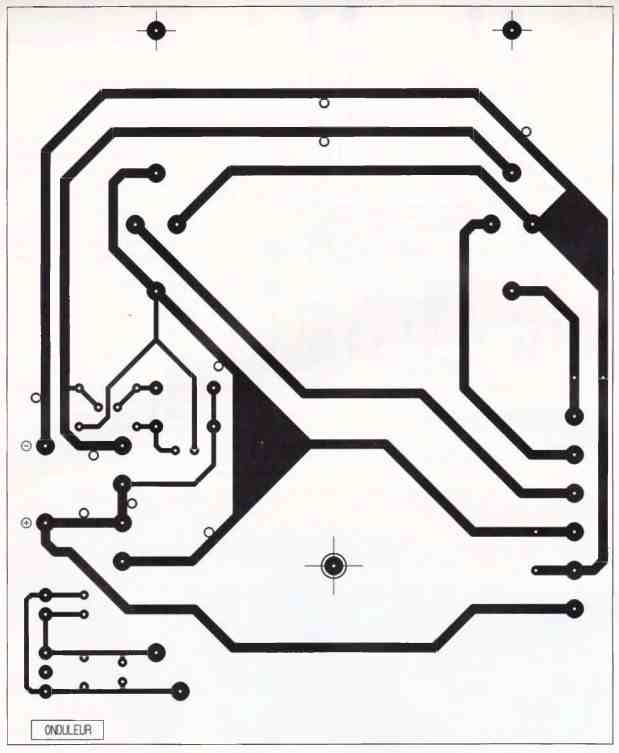
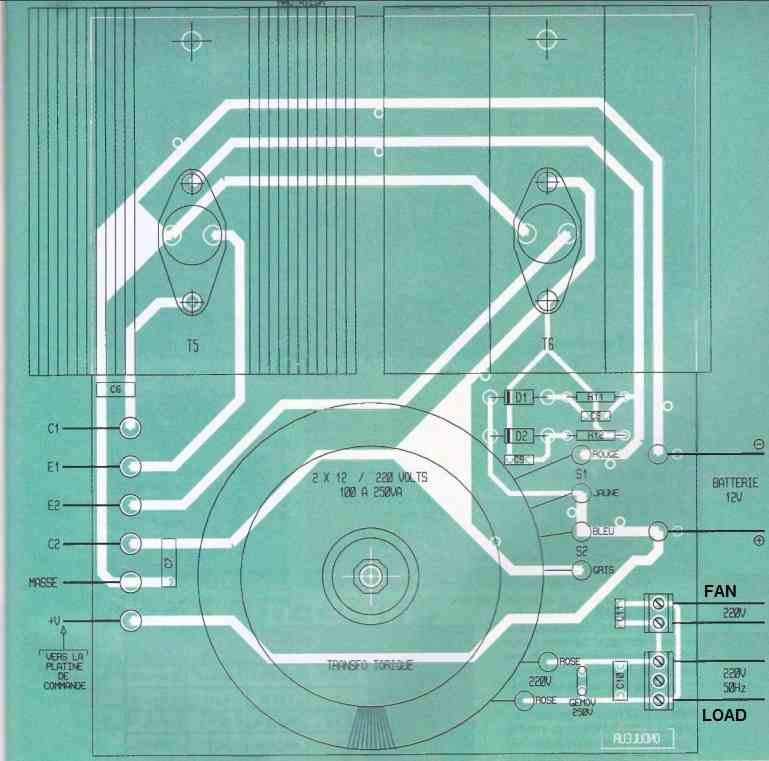
It should be noted that certain tracks on this simple IC 4047 inverter circuit board will carry high currents and require special treatment. We recommend soldering bare copper lengths, with a section of approximately 1.5 mm2, directly onto these tracks.
For example, electrician's copper wire with the insulation removed can be used. Care should also be taken to ensure all connections between the two boards, and in particular, to avoid reversing the wires.
The transformer has six wires, with the two thinnest wires corresponding to the primary, and therefore our 220V output.
It is important to properly identify the other windings before soldering them permanently. This assembly can be housed in a sturdy, adequately ventilated metal enclosure.
How to Setup
We leave it to you to complete this final step for this simple IC 4047 inverter circuit. After a thorough check, the frequency can be adjusted to 50 Hz under no-load conditions using the adjustable preset P1, if you have an oscilloscope or frequency meter.
Otherwise, simply set this element to the midpoint position. The other two adjustable components are set to obtain a symmetrical signal in amplitude.
Initial tests can be performed using a simple socket where different power lamps can be connected. For resistive or slightly inductive loads, there should be no serious issues.
Proceed with caution when testing devices that typically require a true sinusoidal voltage.

ok sir i got it right now the circuit is ok but sir what nest for me to do to make it handle heavy load?i put 220 fan it work but the speed is very low and put 60w bulb it lit up well i have sent you the pic of it to this email address homemadecircuits@gmail.com including the wave form of it check it for me if the wave form is ok it is a trangular wave form or pure sine equivalent?
thanks Biannz, I saw the images, where did you check those waveforms if it's at pin5 of IC2 then it's fine, if it's at the output of the transformer then it's NOT fine…the output will not generate triangular waves rather an approximate sine wave…..connect a 0.22uF/400V capacitor across the output of the trafo and check again.
ok sir thank you sir plse in the 4047 i build this circuit but the problem is i got 4.7v at pin 10 and 4.9v at pin 11,sir pin11 going to the fets gate got very hot it almost burn
the fet could be faulty or wrongly connected, there cannot be any other reason…
Then what may be the reason for the reduction in the voltage, which i had already shown to you Sir ??
procure a multimeter which has a peak voltage detector or a MAX voltage detector option, the feature will enable you to see the max voltage at any point….. and the meter will also lock the result for proper reference.
or it would be even better if you could go back to basics and learn how CMOS outputs behave and what the 555 PWMs are made up of and how they work.
I forgot to ask you an another doubt :
In your last comment you said this,
" if you have connected the diodes directly with the BJT bases then it would work normally as before. "
So you mean, if i am gonna use Transistor amplifier section, it will only function like that stage without PWM feature ( Only Square wave AC output ) ???
if the pwms are removed the circuit becomes an ordinary square wave inverter.
hi sir it been a while sir you have renew this circuit sir please what is the purpose of the 10kpots? sir please can you tell me the value of c and r with bc557 thank you.
Hi bianzz, the 10k preset or pot may be used for trimming the output voltage to the correct level. For example if suppose you are getting 300V initially, you can adjust the 10k pot until the outputs settles down to 220V, conversely if initially the output shows a lower level such as 180V, the same may be used for pulling it up to 220V
Let me try to do the updation Sir.. I would let you know the results soon….
But what z about the reduction in voltage at gate terminals when PWM stage came to act ( without using any transistor amplifier stages ) ? Any solution for it, to maintain full voltage at the gate terminal, at any conditions ??
the peak voltage from the IC outputs and at the mosfet gates will be always equal to the supply voltage that's applied at the Vdd of the IC.
THe transistor stage that you have used serves no purpose.
PWMs are made up of high pulses and zero pulses, during high pulses the diodes are completely blocking them, meaning during these periods the gates must be getting the full IC output voltage, how can the peak voltage drop then??
Only during the zero pulses from the PWMs, the gates are forced to become zero (grounded) through the diodes.
The oscilloscope images in the previously referred article by Robin peters clearly show this effect
I have introduced the transistor amplifier before the gate terminal, and the PWM diodes are connected to the base terminal of the transistor ( using a 10 K resistor ) along with the resistance from output terminal of IC4047….. ( i have send the image to your mail…. Plz check it out )….. Then output of the transistor ( collector ) is then directly connected to gate terminal….
Sir, my frequency meter could show high frequency waves at gate terminals ( say 520 Hz under PWM ) keeping the transistor amplifier disconnected… It could also show 52 Hz when PWM stage disconnected…..
The noticed thing is : when the frequency is checked at the collector terminal of the transistor without pwm, it was the same 52 Hz…. But when it is checked again under PWM ( 520 Hz seen at the base ), it shows the same 52 Hz reading……….
if you have connected the diodes directly with the BJT bases then it would work normally as before.
The frequency will be 50 Hz at the trafo output but the meter will not be able to pick it up due to harmonic content.
I have update the RMS control circuit above, you can check it out.
Sir Now i got exactly what those digital meter readings say exactly at gate terminals… I could found the actual peak to peak voltage by the method you suggested last time ( taking voltage across a 10 uf capacitor……… )…… THANKS FOR GUIDING ME THROUGH THE RIGHT PATH….
As i said before the voltage at the gate terminal reduces from average 6.0 V ( 12 V pp ) to average 2.8 V ( approx. 5.8 Vpp), reducing the power considerably….. But when i am connecting transistor amplifier stage before each gate terminal, voltage retains the peak level ( 5.8 V average ) and the power increases as in the case without PWM….. On checking the frequency at the gate terminals ( collector terminal of transistor ) i got only 52 Hz, but it was found to be 520 HZ something at the transistor base terminal, so actually functions as the stage without PWM…… So i have some doubts..
1). What z the reason for this mismatch ?
2). How to make use of these transistor amplifier stage efficiently to avail full voltage at each
gate terminal with PWM connected, producing maximum power output ?
2). What is the reason, in the original situation ( without the use of any transistor amplifier
stages ) behind the considerable reduction in voltage in gate terminals ?
I could understand, by reading your last comment, that the output voltage will reduce considerably if a 1 uf capacitor is used at that terminal and the battery will drain quickly. And also found the circuit you have suggested that could compensate for higher value capacitors being used in co-operation with inductors… So
3). Can you suggest me a method by which any valued inductor can be made by hand ?….. I
have copper wires with me
Arun, I think still you haven't understood the utility of the PWM stage
PWM is introduced to chop and reduce the final RMS so that it matches with the real sine AC RMS approximately.
A lower voltage transformer is intentionally used to counter this drop so that it can be raised to the desired levels by the trafo.
You cannot get 5.8V, the peak voltages from the IC will be always equal to the battery voltage under any case.
As far as the inductor is concerned I have no idea about the calculations, it could be quite complex.
By the way in your transistor amp where did you insert the PWM diodes?
you will need an oscilloscope for measuring the actual frequency, your meter will give wrong results due to the high PWM frequency insertion over the basic 50 Hz.
Sir,,
Could a high value capacitor ( say 1 uf / 400 V ) be able to suppress harmonics in ac instead of 0.1 uf one. In our area 0.1 uf / 400 V capacitors are rare…. I have more than 10 no.s of 1.5 uf/ 400 V capacitors with me.
So will the below given schematic be more useful ??
4.bp.blogspot.com/-o0KcHSbQKlE/UsQmcGY3NzI/AAAAAAAAGE0/LhlxgAGj7vM/s320/inverter+sinewave+filer+circuit.png
Arun 1uF would drop the output voltage a lot and drain the battery fast, so such high value is not recommended.
however a design by Motorola shows that it's possible to use such high value capacitors in conjunction with an inductor, you may see the following image and try it accordingly if you wish:
4.bp.blogspot.com/-khKat0UA8Jw/UITpCnNd7yI/AAAAAAAAA_A/8x-KAD2aHLE/s1600/simplest60+Hz+Inverter+circuit+diagram.jpg
Sir you mean, connecting the diodes( 1N4148 ) of the output voltage regulator to the gates of the MOSFETS ?
Two diodes are already connected to those terminals for sine wave operation, reducing the voltage at those terminals from 5.9 volts to around 3.0 V…. So if we are gonna connect the diodes in the regulator section again in the same place, will that voltage be reduced again to a small value so that the MOSFETs will be unable to conduct ???
As i have noticed from the design that the gate voltage when the PWM stage connected was only 3.0 V, Is that possible to think for a single transistor amplifier or anything like that to boost this voltage for maximum power output ?
Arun, yes that's right, connect the diodes from the regulator circuit too at the gates of the mosfets.
these diodes will only conduct when the output is above normal, otherwise they would be inactive.
PWM is introduced to carve the voltage as per the duty cycles of the pwms, so the voltage will reduce….but 3V is the average voltage that you are seeing, the peak voltage of the gate pulses will be always equal to IC supply voltage…measure the peak by using a suitable digital meter set at "peak" or "MAX" voltage at the gates.
it's your wish, if you want to use BJT stages you can do so.
Sir, if i am doing so will there be any confusion arised to IC2 stage in comparing the signal arrived at its pin#5 with the high frequency signal ( say 2 Khz ) arriving at its pin #2.
Because, there is already a sawtooth / triangular wave reaching pin#5 from its generator.. So if i am incorporating the additional optocoupler stage, there is also an another signal to pin#5 from this… So how would that comparison be look like, means how the IC2 stage is gonna efficiently handle this situation without changing the sine wave nature of the inverter also incorporating output voltage correction feature.
I am also having another doubt,
Can any high frequency be used to compare in the IC2 stage ? Any problem with 2 Khz wave ?
yes, let's not disturb the sawtooth at pin5 of IC2, it'll produce wrong results.
I think the following idea is the best one:
https://www.homemade-circuits.com/2014/01/automatic-output-voltage-regulator.html
frequency at pin2 of IC2 is not critical, it can be of any value but not too high, 2khz is OK.
Sir,
Eventhough i am working in musical industry ( Music production ), i am a big enthusiastic of making such small small electronic projects…. I am used to go through almost every projects you posted in this blog…. So i have noticed the making of that optocoupler also.. That automatic output voltage regulator, i have also noticed… I am very much confident in building even complicated designs myself using the basic knowledges in electronics, i had achieved in my whole life…. But to complete and make the undertaken project working, valuable helps and suggestions from experts like you are necessary…
So could you plz tell me sir, to which point in this circuit, i should have to connect the optocoupler for solving the output voltage regulated issue ??
Arun, the connections will be exactly identical to the one shown in the original schematic, pin5 of IC2 is where it needs to be integrated along with the associated resistors
…..pin5 of the triangle wave generator IC could be also tried for the same.
Sir can a LED/LDR optocoupler as in the figure given below
4.bp.blogspot.com/-Y2aIrZugaFY/UselIcNJh1I/AAAAAAAAGG0/sxZw8y5fDCs/s1600/pure+sine+wave+inverter+with+auto+correction+circuit.png
be used as a output voltage regulation circuit for the current 4047 design ?
If it is possible, where should it be connected ????
Arun,
this design will be difficult for you,because first of all you'll have to make the LED/LDR optocoupler perfectly, which could be a lot difficult for you.
instead you can try the following circuit for the same application:
https://www.homemade-circuits.com/2014/01/automatic-output-voltage-regulator.html
ok sir but i want know that it this circuit a pure sine wave? thank you
it's not pure sinewave but has all the properties of a pure sinewave.
ok sir thank you but sir there is ic two which of them should be adjusting frequency? can i do without the led and ldr?
The one which is associated with pin14 of 4017 is for 50Hz frequency.
the LED/LDR is only for automatic load correction.
sir thank you.sir please tak a very look at this circuit for me the second circuit you said it is implemented by the inclusion of the LED/LDR opto-coupler stage. i build it it work so sir please should i set the frequency at the out put of tranf or at the pins of the ICS as you shown 180k preset? 300 Watts PWM Controlled, Pure Sine Wave Inverter Circuit with Output Voltage Correction
sir pls can i you IRF1404 in place of IRF540N?
sir it this circuit a pure sine wave?
can this circuit be build up to 5kv 5000W?
can 4n35 be replace the led and LDR?
it s possible to use 24v DC? thank you sir i will be happy if you answer all this questions one by one for me to understand it well
biannz,
LDR/LeD module is NOT for adjusting frequency, it's for adjusting the output voltage.
for frequency setting, do it by adjusting the IC1 preset.
check the datasheet of the mosfet, if it's wattage is beyond the desired load wattage, the you may use it.
first make it to handle 200 watts correctly then we can proceed for higher loads
only LDR will work, nothing else can be used.
24v can be used, but use 7812 for supplying the ICs, else the ICs will fry at 24V
sir please in this circuit
300 Watts PWM Controlled, Pure Sine Wave Inverter Circuit with Output Voltage Correction you design it two times which one is correct and can be use? you detected ic1 ne555 and bd135 so which one it should be contracted?
sir please answer this two question thank you.
sir i have sent you a video and the circuit,i build it i got 4.8 frequency going it don't stable and i got 223AC at out put so sir can you please help me cos i don't think this can handle a load i put 220v AC fan but it couldn't
biannz, I did not uderstand what you are asking, where is BD135 in my design, please provide the link
the load handling capacity will depend on battery size (AH) and trafo size (Amps) if you dimension these two correctly,you will be able to make it handle the desired wattage loads.
…ok I i understood now….the following diagram is correct and more appropriate:
4.bp.blogspot.com/-Y2aIrZugaFY/UselIcNJh1I/AAAAAAAAGG0/sxZw8y5fDCs/s1600/pure+sine+wave+inverter+with+auto+correction+circuit.png
sir i got 120.5v dc at pin3,p1 i use 100k,R1 39k and C1 10nf
120V from a 12V battery?? how's that possible?
Please note that the 1N4148 cathodes are only connected to pin3 of IC2 and nowhere else.
sir please i checked all over the circuit everything is connected as it showed i didn't make any mistake sir the problem is the two diode if removed it work but if i connect it doesn't,sir pls is there any way to change the direction of the two 1n4148 diode? i used 6-0-6v transformer but not seem to work sir.
check the voltage at pin3 of IC2, it should be around 50% less than the battery voltage,
the lower 555 stage is creating the pwm waves which is fed via the diodes to chop the mosfet gate voltage causing them to conduct according to the pwms, thus forcing them to generate the sine waves over the trfo.
your 555 stage may be faulty or with tecnical issues.
sir please if i connect two 1n4148 diode the circuit don't work im confused i need your effort
it will not work if your 555 circuit is faulty, check the waveform at pin3 of IC2, also check the voltage at this pin.
use 6-0-6 trafo for 12V battery
ok sir thank you for your kindness im quite appreciate,sir i did as you said when i got 5v at pin5 of ic 2,when i remove the tow 1n4148 diode the circuit work so i got 152ac out put but there is some noise from the circuit i have sent you the video so please check it for sir why the noise? sir what is the per pose of the two 1n4148 diode and can this circuit be use without two 1n4148 diode?.
biannz, use 6-0-6 trafo if the battery is 12V, this will give 220V approximately even with the diodes connected.
you get pwm sinewaves only when the diodes are connected otherwise it's just square wave.
the diodes shape the mosfet gate triggers into digital sinewaves.
I am not so sure about the noise, it will be there somehow, try clamping the trafo hard.
ok sir please here are the connection circuit
remove the 1N1448 connection temporarily from the mosfet gates and check whether the 4047 inverter is working normally or not.
It should, if it doesn't means your IC or connections are bad.
If it shows normal response, check the following things in the 555 section:
frequencies at pin2 and pin5 of IC2 and also the respective voltages at these points, tell me the results, i'll instruct you with further procedures.
ok sir i have sent you the pic sir please try to help me build this circuit even if i survive building this circuit i will not go for any other inverter circuit i hope this circuit is good enough for me if you help me, sir please im appealing to you if it could be possible for you to send me the prototype if you have a time to design it thank you hope to hear from you.homemadecircuits@gmail.com
as expected you have only simulated the design and have not tested it by building it practically.
pls don't discuss simulated results with me.
procure the components, build it practically and only then confirm the results with me.
hi sir it been a while,sir please i build this circuit but unfortunately it don't seem to work sir any help? thank you
hi biannz, pls show me the picture of the built prototype including the connections that you have done, I'll try to help.
sir please it D1 a zener diode 2.7v?,sir please i have check 4047 on Google and a lot of them but sir there something i don't understand please explain it for me the 4047 it produce square wave so how come this inverter be produce pure sine?
the 555 stage need to be power? thank you sir.
D1 is a 2.7v zener diode.
the 555 stage is responsible for generating sine wave outputs from 4047.
555 is powered from the battery itself.
sir in my circuit i,m having 50.79hz in both pin 10 and 11 and 101hz pin 2 of ne555, 426hz in pin 2 of ic2 and 101hz at pin 5 of ic 2
pleas sir is 180k rsesis a pot? and which of the is responsible for the 2khz and also i use ne555 for the 3 because 7555 is not avalaible. please what could be wrong with my circuit
faith, 180k is a fixed resistor. it's neither a pot nor a preset.
your readings look quite OK to me.
2kHz is not important…you can carry with your present set up.
the 426hz becomes the carrier frequency, and the 101 Hz becomes the modulating frequency for the PWM…that looks fine to me.
sir in this circuit i want to ask you that in the 4047ic can i use (10k for R1) (10k for p1) (0.01uf for c1)?
sir please answer this question for me in fact in my country we don't have this kind of ic (7)555 i never seeing this ic before only we know or we have here is ne555 so can it be use in place of the two ic (7)555 ca i can see the left side of the hand is ne555
biannz, try googling "4047 inverter circuit"…you will come across many designs online where you will be able to get the exact values of P1 and R1
NE555 will also work
Thank you very much sir for replying.
I will inform you any changes ,will occur doing further verification of the entire circuit.
What is the part no. of the optocoupler being used with an LED for output voltage regulation in the picture given in the link you provided ? Can i make the combination manually. How it can be done ?
You can refer to the second image in this article, it shows how to build an LED/LDR opto-coupler at home:
https://www.homemade-circuits.com/2011/12/how-to-build-simple-electronic.html
Sir i found the modification done to this circuit by Mr. Robin at earlier times as in the figure given in the following link.
http://www.google.co.in/gwt/x/i?gl=IN&wsc=hg&u=3.bp.blogspot.com/-7PTqKTB9Gvk/UmYcnX3OFiI/AAAAAAAAFiU/F0mIzZBOjNo/s320/inverter%2Boutput%2Bvoltage%2Bcorrection%2Bcircuit.png&hl=en-IN&ei=dXvRUuWYKcfliAfQv4HwCQ
I tried your basic circuit as well as this modified one. But the results were not fruitful and remained the same providing an ac output of around 20 V only.
Please read what changes i had done to this…..
Since i do not have an oscilloscope with me i was unable to make out an exact 2Khz by the first 555 in the modified version. But i have a simple digital frequency meter with me. So i could confirm the frequency of the last 555 ( which gives clock pulses to 4017 ) out to be exactly equals 200 Hz. I thought this 555 stage is a 50% duty cycle pulse generator ( since it employs diodes ) and the resistances 1 K and 3.4 K were replaced by 470 ohm and 10 K respectively and tweaked the 10 K pot to make the output wave form exactly equals to 200 Hz. After confirming this step I HAD USED THE SAME 555 STAGE to generate 2 Khz signal, but this time 0.05 uf capacitor was replaced by 0.5 uf one ( because of the formula for frequency of 50% duty cycle wave as f=1/(0.69RC) )
Now it is expected to produce a 2 Khz signal by the first two 555 ics. I have also made a change that 4047 was used instead of 4017 and the pulses from 3rd 555 stage were fed to pin#13 ( CLK INPUT ) of it. No more changes to say
Now i have some doubts…
1). The voltage at gate of each mosfet w.r.to ground had reduced to 1.3 V compared to the simple configuration in which no pwm section were used ( 5.6 V ). How to solve this issue sir ? thereby i am getting very low ac output
2). Will the frequency of pulses fed to the gates be 50 Hz even after feding the pwm stage ? ( i am getting higher values compared to the simple configuration not using pwm in which 50 Hz was shown )
3). How to use the 10 K pot in the 2nd 555 stage in the modified version ?
4). I have found a more better circuit provided by Mr. Theofanakis at the last page of that article given in this link
http://www.google.co.in/gwt/x/i?gl=IN&wsc=hg&u=2.bp.blogspot.com/-j_f23T5_4l4/UnxgdQS3eGI/AAAAAAAAFpY/0s7ogZHW1HA/s1600/modified%2Bsine%2Bwave%2Ba.JPG&hl=en-IN&ei=RYXRUvfoFubriAfH_4CQBw
Will it be more effective and can be used for even sophisticated applications ?
I am expecting your reply as soon as possible sir
Hi Arun,
The referred design has been tested and verified by Mr. Robin and by Michael so there's no doubt regarding its working.
The reason behind your circuit not working would be difficult to diagnose without seeing it practically,
I think you should proceed step wise, first check the circuit without the PWM diodes and then again by connecting the diodes and adusting the PWM mark space ratio.
If the 4017 version is also not working then surely there could be something hugely wrong with your circuit configuration.
You may refer to the following design to et a clearer idea:
4.bp.blogspot.com/-Y2aIrZugaFY/UselIcNJh1I/AAAAAAAAGG0/sxZw8y5fDCs/s1600/pure+sine+wave+inverter+with+auto+correction+circuit.png
please sir the circuit in this link i.e 4.bp.blogspot.com/-Y2aIrZugaFY/UselIcNJh1I/AAAAAAAAGG0/sxZw8y5fDCs/s1600/pure+sine+wave+inverter+with+auto+correction+circuit.png ii it the same as the one as the one you design using 4047 ic what is the name of the ic with 16pins i.e. ic 2 and the Led were is it linked to also can i use 12-0-12 transformer to build it?
waiting your reply
faith, yes it's quite the same, but the LDR/LED concept ensures an over voltage control for this inverter
sir its this circuit a pure sine wave Pure Sine Wave Inverter Circuit Using IC 4047 and also what is the different between ne555 and (7)555 can i use ne555 for all the three ics? can irf540n be ok without problem?thank you sir i am waiting for your reply.
it's a pure sine equivalent circuit.
ne555 will provide more current (200ma)at the output and will also consume relatively more current during non-operative conditions and will need minimum 4.5V to operate.
7555 will produce not above 10ma at the output but will work with very low current and even at 3V supply.
i dont have 7555, so we still can use NE555 instead of 7555 ???
any 555 IC will do…
(7)555 is CMOS digital based IC with current output not more than 20mA, whereas ordinary 555 are analogue based however with output current as high as 200mA
Sir as you suggested at the last time, i have tested the single inverter circiit using only IC4047. At first time i got some ac output, but after sometimes nothing came out through transformer secondary. I saw a reduce in battery voltage when it had connected to the 0 tap. I am using a power transformer rated 20 to 25 A at secondary and batteriea are rated 20 AH 12V each* 3 no.s.
This time i didn't use any dioded for the parallel connection. But the result was the same with diodes. Please help me
12-0-12 trafo will be OK if you are not incorporating the lower PWM stage, if you want to include the pwm stage then a lower voltage trafo becomes essential.
You might have blown off the mosfets, or the IC, or your battery could be dead.
You can try using transistors instead of mosfets as they are easier to handle. you may take the help of this article to know how to connect the transistors:
https://www.homemade-circuits.com/2012/02/how-to-make-mini-homemade.html
connect 12v head lamps to your battery and check their intensity to confirm the battery condition, and for the inverter circuit use only one battery initially instead of using all the batteries together.
Sir a 6-0-6 power transformer is not with me. Can i use the 10-0-10 tap of the one already have. What happened if 12 V tap is used.?????
Sir by measuring frequency in ac socket ( putting negative lead to N and positive to P aftet setting ti frequency range ) i got a value near 150 . Is it correct???? Actually should it be 50??'?
Sorry 4 the bad english
Sir can i use a battery of the order of below 100 Ah such as 50 or 60 Ah with a 300 W transformer intended to produce the required wattage only ( less than the rating of the transformer ). ????…..
When i am connecting a single 20 Ah battery to the simple inverter using only IC CD4047 i am getting ac out, but when 3 or 4 batteries are connected in parallel no ac output……. when ac is present there is a humming noise produced by the transformer……. I have used the parallel connection schematics as explained by one of your earlier posts in which diodes are used
yes you can use lower rated batteries for operating the rafo with lower watage
check the voltage of your batteries when connected in parallel, the diodes mus be rated for carrying over 10amps, use two 6A4 diodes in parallel…..or may be you can try them without the diodes too, if all are above 12.5V
Sir what does it means 'D1 2V7'
Is it a zener diode????
Can i use a 4V7 zener. In my earlier doubt, i had forgot to say you that i have used a 4V7 zener in this place
4.7V zener will also work, don't bother about the lower 555 circuit, remove the stage and check only the 4047 inverter first.
If it works only then attach the 555 circuit with it.
you are getting 2.7V at pin5 and 2.5V at pin3 which are almost equal, so may be your circuit is working correctly.
remember your trafo voltage should be 50% of the battery voltage,means if battery 12V use a trafo rated at 6-0-6V
Hello brother nice work. I always appreciate your posts. Kindly help me with one thing that's confusing me. I am using IRF3205 power mosfet. As i am understanding just two irf3205 can deliver 600W power. What do you say? and also what if i use 4 irf3205 to have the same power on the same transformer which is 220v-500Watt
Waiting to hear from you.
Hello Xaidi, thanks!
yes if the mosfets are adequately cooled then it could be used for switchng that much power.
the transformer is the actual power source, while the mosfets are just power switches, therefore the output will finally depend on how much the transformer is able to produce, the mosfets are only responsible for switching or carrying this power, so it will have no role in developing or enhancing the output power….
I am not getting 3 to 5 volts at pin#5 of IC2. Only 2.72 V
Also pin#3 voltage is 2.5V seen that is not equal to that at pin#5. What to do
Is this circuit a tested one???? ALSO TELL ME HOW TO MEASURE FREQUENCY AT RESPECTIVE PINS USING A DIGITAL MULTIMETER. I can see a square wave symbol in the meter, but don't know how to connecte the leads to measure hertz
Did you study and understand the complete functioning of this inverter before building it?
The above circuit is a complex design and is only meant for experts hobbyists.
I would suggest you to first learn all the basics of inverter and then go for the practicals.
You should first try building a simple inverter.
Sir what type of optocouplet i have to use for a 250 W inverter??''
Ram, no buffer stage is required accordion tome…..i would advise you to first successfully build the above shown inverter, once its working is confirmed we can go ahead with the opto stage.
Sir please help me in identifying the connection of an optocoupler to this stage for automatic load correction. I found one in your previous article, but there optocoupler's +ve terminal is connected to the RMS voltage. I can't distinguish that from this situation.
Also can you add a selectable overload protection circuit in this schematic. Even an overload indicator is enough for me
Sir how a buffer stage can be made which solves the problem said by Mr. ALEX
Forgot to say sir. I have used IRF540N instead of IRF150 in the circuit. Also there is a slight change in the value of C1 and C2 used. I have used a 0.1 uf ceramic capacitor at the oscillating circuitry of the IC CD4047. Resistance R1 used is 22.7 K (adjusted by a potentiometer ). These values were obtained by solving the formula
f at 10th and 11th pin = 1/(8.8RC) for 50 Hz at pin 10 and 11.
Instead of 0.1 uf/600V b/w the secondary terminals, i have used a 1uF/450V Electrolytic capacitor.
So i want to know whether does these changes cause that problem….
The issue is no doubt with your circuit connections, either you have connected the mosfes wrongly or the transformer taps.
Try an ordinary small 12-0-12/220V transformer with your circuit and confirm whether your circuit connections and working are OK or not.
Once your circuit working is confirmed, next you can connect different taps of your actual trafo for the intended correct results.
Connect a 12V car headlight lamp in series with your battery positive…this will restrict any possible short circuit hazard and blowing of mosfets.
Sir,
Prior doing this project i had just tested the working of a simple inverter using IC Cd4047 as given in this link
1.bp.blogspot.com/-z9RRPSTi8zs/UbR4uKyuLRI/AAAAAAAAESo/rGu-sAhOqio/s1600/IC%204047%20inverter%20circuit.jpg
But it got failed. The problem is that when i am connecting the center tap of the power transformer to the battery positive a spark appears and battery charge goes down to zero voltage and no ac output.
I am using a 300 W 15V power transformer with 5 primary taps and 4 secondary taps. The 15-0-15 voltage has been taken by
1st and 4th tap wires being +15V and -15V respectively and the 2nd and 3rd wires rapped together to avail 0v. The battery being used is a 12V 20 Ah battery
i have also tried with taps 1-3-4 and 1-2-4. But the same problem persists. So will you please help me in solving this issue.
Is there anything wrong with my transformer …. I have used the high power transformer and the battery without considering their specification, my only aim was to test whether the inverter functions properly, and then only proceeding to further high power design
the 555 at the left will produce triangle waves having peak voltage = 2/3 of the supply only as per its internal specifications
may be because the triangle wave peak is not equal to supply voltage, it's only 2/3rd of supply.
hello Mr Swagatam I had a try at the circuit again but had some problems. I got the 100 hz at pin 5 2khz at pin 2 . The 4047 section as a inverter works but as soon as i connect the diodes to the gates the output voltage just comes up to about 20v and goes right down immediately dont know if something is wrong with the circuit diagram. please help us here Sir.
Alex, check the output voltage at pin3 of IC2 555, it should be around 30 to 50% of the the battery voltage meaning around 3 to 5V.
Connecting the diode to bases of the mosfets will drop the output voltage but not to 20V that's too low.
please check and tell me about the above readings.
ok Mr Swagatam I think I will give this circuit a break for now and start to build the other circuit that Mr Robin is persuing in that his own seem to working to a certain stage sir I will let u know the results
hello Mr Swagatam I have been following a lot of ur other circuits and built a few so far. How could u incorperate a output voltage correction circuit in this design because i know that with varing loads we will get a voltage drop here. Thank u for ur support
hello Alex, it can be done by adding a opto couper circuit across pin#5 of the right hand side 555 IC, quite similarly to the method discussed in one of my previous posts.
ok thank u Mr Swagatam I am going to build this circuit until Mr Robin comes up with the report on the other design with the 4017 I really want to get one of these circuit s going Sir. Thank u for ur support to us
hello Mr swagatam i am trying to understand ur principles every day more and more. Please tell me if I have it wrong . Lookin g at this circuit is it possible to use sg3524 in place of the 4047 and send pin 3 which is the oscilator out from the sg3524 and feed the two 555 ic just the same way as how u send the pin 13 of the 4047 to these two ic.. Would we get the sine wave effect with this ic.Thank u Sir just want to know if I am learning or I am wrong on the principle
Hello Alex
yes IC 3524 can be also applied similarly, however IC 4047 fits better here due to its simpler configuration.
thank u Mr Swagatam I want to make sure I am unerstanding the principle because sine wave inverter circuits are so hard to find online and every body discourage us from building them but u make it look so simple in ur designs well I think the filtering part might be the hard part. Still waiting on Mr Robin to come back to us witht the finish product of ur 4017 sine inverter. Thank u Sir
Thank you Mr. Alex, let's wait for Mr.Robin's response…. or may be you can take it ahead from here and finish the project with your efforts.
hello Mr Swagatam I seee u have changed the above circuit by adding another 555 should we build it this way now instead of the first circuit . could u explain this new addition . Thank u Sir
Yes, we need to build it in this way. The chopping pulses needed to be of much higher frequency than the triangle pulses, that's exactly what's been modified in the new design.
ok thank u Mr Swagatam I built the top section lastnight with the 4047 and that section works only that I cant really set the output voltage to the exact amount i need because ther is no control pot for this >. Monday I will build the other section and tell u the result Thank u Sir
Mr swagatam what is the value for c and for resistor r thank u
That's great Mr. Alex, wish you the best!
R = 1K, C = 1uF
Thank u Mr Swagatam for ur help I am getting the parts together to build. I hear they talk about efficiency of sine wave inverters being difficult to achieve thats why we should buy instead of building what is the efficiency of this inverter and would we need a filter after the transformer . If we need a filter could u add for us please. Thank u Sir
Mr Swagatam I built this circuit but I am having problems with it . The section with the 4047 works I get my ac voltage out ok . When ever i connect the bottom section ( the two diodes to the gates the circuit shuts down and no ac commes out..I even loose the drive signal from the 4047. I dont have a scope so it is difficult to show u any wave form. All I can say is I am getting about 91Hz from pin 6&7 junction with the collector junctuon from the left ic that signal that goes to right ic pin 5. I get about 552hz from pin 3 of the middle ic and about the same from the right ic pin 3 just dont know wher to go from here. So as long as i lift the gate drive from pin 3 of right ic the circuit comes on again. Please help me here Sir. Thank u
Mr Alex, Where did you hear this? Please show me any link where this is discussed.
Modified sine wave inverters are actually controlled square wave inverters, so they are as good as a square wave inverter.
Please check the following things in your inverter design:
Check frequencies at pin5 and pin2 of IC2 (extreme right 555)
Pin5 should show = 100Hz approx
Pin2 = high frequency…2kHz will be OK, adjust 180k resistor for this.
The voltage at pin5 and pin3 of the above IC should be approximately equal.
Thank u Mr Swagatam I will check tomorrow. What component would adjust the 100hz frequency at pin 5 of ic2. Thank u Sir
Hello Alex, P1 of 4047 IC will adjust the 100Hz frequency at pin5 of IC2.
Thank u Sir I will check again and let u know
hello mr swagatam i really have to confess to you, since i've come accross this site i've been addicted to it, thanks for being a mentor and also a teacher to me, i realy appriciate the good work and effort you've put toward educating people like me thanks once again.
It's my pleasure Saheed!
Help me
That's correct Robin,
I'll correct the design as soon as possible.
Please help me
Please. Can you add the output waveform of the circuit. I really want to built this inverter this weekend. Thank you sir.
I have updated the article with the waveforms, please check it out
I will test it.
Thank's!
Sir, can more number of FETs be added for higher power ?
Yes, more FETs can be added in parallel for more power
good
Dear Sir,
Thank you for a nice and simple schematic.
By the way what are the values of capacitors which are
connected to pin 1 of both 555 IC's ? You mentioned them as
C and C only.
Thank You.
Rashid
Dear Rashid,
Thank you! Both Cs can be selected as 1uF/25V
Hi sir thanks for your support every time please sir this questions may sound stupid but sir I will appreciate if you can answer me
1,please can I make thThe 2nd circuit without oscilloscope and frequency meter because I want to make it but I don’t have any of them but I have multimeter am still saving some money to get a portable oscilloscope sir if yes can you please ???? tell me what am going to do ???? ????
2,please sir if you have a whatapp number can you please drop it or send it to me through my gmail Omikunlee@gmail.com am looking forward to your reply. Thanks in advance
Anytime I see a simple electronics circuit like this I always make sure I practice it because I love ❤️ building electronics the circuit is simple to me but the oscilloscope and frequency meter is my problem I know soon I will get one but please ???? ???? help me with this
If you want an easier sine wave circuit which can be tested without an oscilloscope then you can try the second design from this article:
https://www.homemade-circuits.com/modified-sine-wave-inverter-circuit-2/
Hi Omikunle, without an oscilloscope it can be impossible to know whether the circuit is functioning correctly or not, and troubleshooting can be even more difficult, so a scope is a must for this design